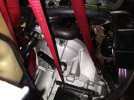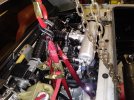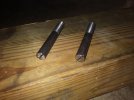rcarlson2bx
Low Mileage
I'm having problems re-installing the 5-speed transmission on my '81 FI X1/9. I have the rear A arms out and the car is on jack stands. The transmission will not mate to the engine block because the bump-out for the CV joints is hitting the rear frame cross-bar. I made a drift pin and placed it in the upper forward bolt hole, and can see that the transmission needs to rotate about 10 deg counter-clockwise to get the upper rear bolt hole and the lower rear stud to line up. I think the problem is that the engine, which is still in-place, has rotated and that' s what is causing the misalignment. Should I remove the reaction rod to make it easier to get things to align? Any other suggestions or guidance? Thanks in advance.



